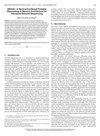Toward Scalable RDMA Through Resource Prefetching
IF 1.4
3区 计算机科学
Q4 COMPUTER SCIENCE, HARDWARE & ARCHITECTURE
引用次数: 0
Abstract
RDMA network is being widely deployed in data centers, high-performance computing, and AI clusters. By offloading the network processing protocol stack to hardware, RDMA bypasses the operating system kernel, thereby enabling high performance and low CPU overhead. However, the protocol processing demands substantial communication resources, and due to the limited hardware resources, commercial NICs (Network Interface Cards) experience a significant number of cache misses in large-scale connection scenarios. This results in performance degradation, indicating that RDMA lacks scalability. In this paper, we first analyze the characteristics of resource access in RDMA. Based on these characteristics, we propose a resource access prediction and prefetching mechanism in the hardware, which preemptively fetches the resources required by the protocol processing pipeline to the on-chip cache. This mechanism increases the NIC’s cache hit ratio. Evaluation results demonstrate that our approach improves throughput by 125% and reduces latency by 17.9% under large-scale communication scenarios.通过资源预取实现可扩展的RDMA
RDMA网络在数据中心、高性能计算、人工智能集群等领域得到广泛应用。通过将网络处理协议栈卸载到硬件,RDMA绕过了操作系统内核,从而实现了高性能和低CPU开销。但是,协议处理需要大量的通信资源,并且由于硬件资源有限,商用网卡在大规模连接场景下会出现大量的缓存丢失。这将导致性能下降,表明RDMA缺乏可伸缩性。本文首先分析了RDMA中资源访问的特点。基于这些特点,我们提出了一种硬件资源访问预测和预取机制,该机制可以将协议处理管道所需的资源抢占到片上缓存中。这种机制增加了网卡的缓存命中率。评估结果表明,在大规模通信场景下,我们的方法将吞吐量提高了125%,延迟降低了17.9%。
本文章由计算机程序翻译,如有差异,请以英文原文为准。
求助全文
约1分钟内获得全文
求助全文
来源期刊

IEEE Computer Architecture Letters
COMPUTER SCIENCE, HARDWARE & ARCHITECTURE-
CiteScore
4.60
自引率
4.30%
发文量
29
期刊介绍:
IEEE Computer Architecture Letters is a rigorously peer-reviewed forum for publishing early, high-impact results in the areas of uni- and multiprocessor computer systems, computer architecture, microarchitecture, workload characterization, performance evaluation and simulation techniques, and power-aware computing. Submissions are welcomed on any topic in computer architecture, especially but not limited to: microprocessor and multiprocessor systems, microarchitecture and ILP processors, workload characterization, performance evaluation and simulation techniques, compiler-hardware and operating system-hardware interactions, interconnect architectures, memory and cache systems, power and thermal issues at the architecture level, I/O architectures and techniques, independent validation of previously published results, analysis of unsuccessful techniques, domain-specific processor architectures (e.g., embedded, graphics, network, etc.), real-time and high-availability architectures, reconfigurable systems.
 求助内容:
求助内容: 应助结果提醒方式:
应助结果提醒方式:


